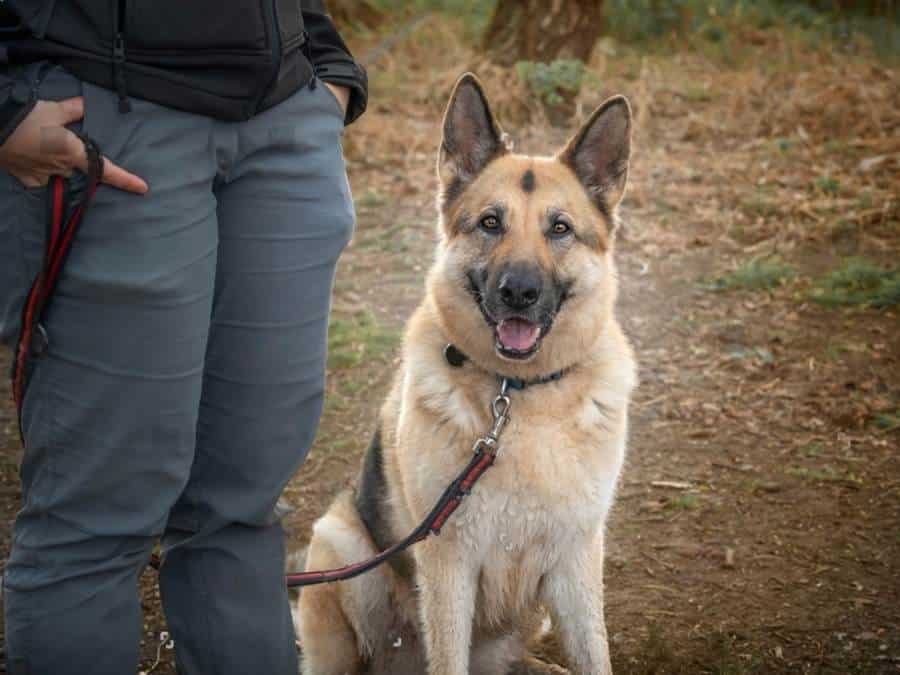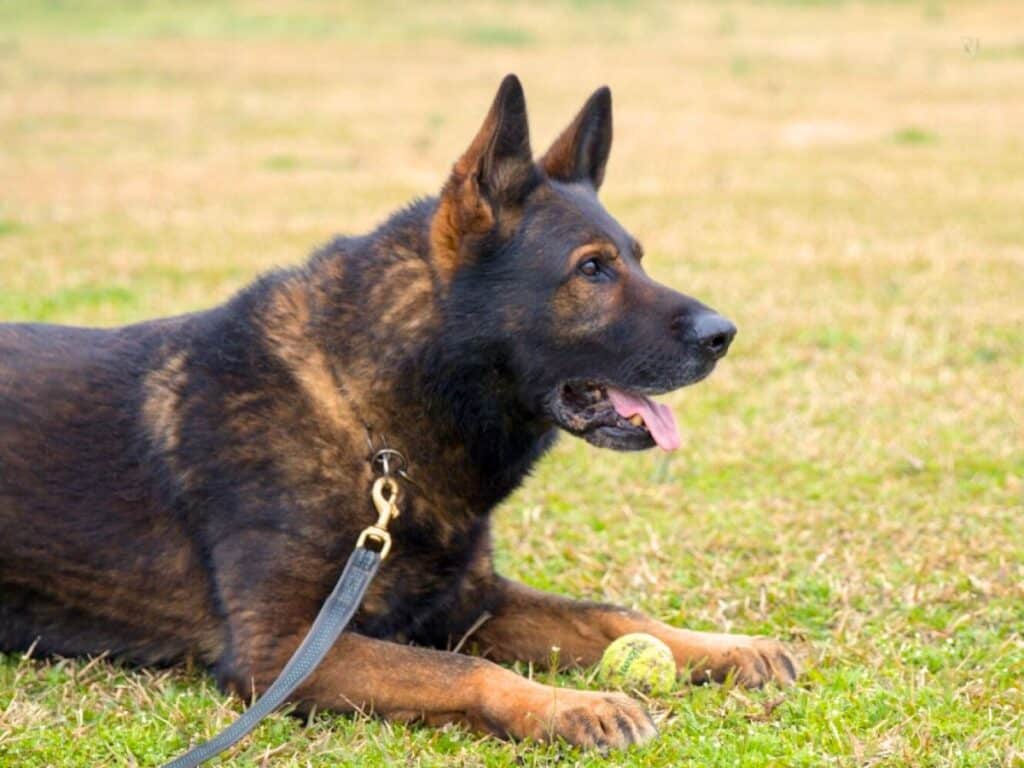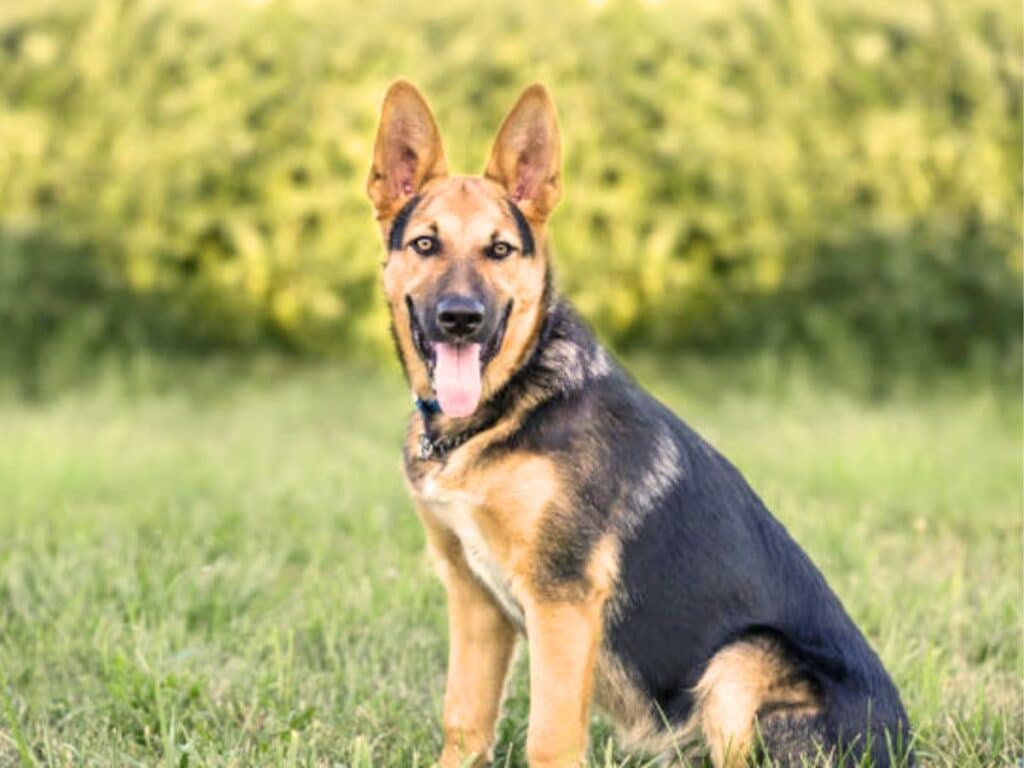Have you ever wondered what it takes to change a dog’s life? Rescuing a German Shepherd dog is more than just providing shelter and food – it’s about offering love, care, and a second chance.
From the initial decision to rescue to the challenges and joys that come with it, today we’ll cover all aspects of this rewarding experience.
Whether you’re considering bringing home a rescue German Shepherd pup or already have one by your side, this post will provide insights, tips, and encouragement for your noble endeavor.
If you already have a rescued German Shepherd at home, feel free to jump to the ‘Bringing Home A Rescued GSD‘ section.
However, if you’re in the planning stages of bringing home a German Shepherd from a shelter, I encourage you to continue reading for valuable insights and guidance on the adoption process.
The following checklist serves as a comprehensive summary, encapsulating key considerations before, during, and after the adoption of a rescued German Shepherd.

What to Consider Before Rescuing a German Shepherd
Before rescuing a German Shepherd dog, it’s crucial to assess your lifestyle and readiness. Dogs require time, attention, and commitment, so understanding your ability to meet their needs is essential for a successful and fulfilling relationship.
Here are key considerations when evaluating your lifestyle and readiness for dog ownership:
Time Commitment
German Shepherds are an active and social breed, they require a significant time commitment. Assess your daily schedule, work hours, social activities, and other responsibilities to ensure you have enough time for walks, playtime, training, and general companionship.
Exercise Requirements
German Shepherds are known for their high energy levels and need regular exercise to stay healthy and happy. Evaluate whether you can commit to daily walks and daily play sessions.
Space and Living Environment
Consider your living situation. Do you have enough space for a German Shepherd to move/run around comfortably?
If you rent, ensure that your lease allows for dog ownership, and check for any breed or size restrictions.
Consider Financial Responsibilities
Owning a German Shepherd Dog, or any other dog comes with financial responsibilities, including food, grooming, veterinary care, vaccinations, and potential unexpected expenses. Assess your budget to ensure you can provide for your dog’s needs.
Emergency veterinary care and unexpected health issues should be factored into your financial planning.
RELATED: German Shepherd Price: Total Cost of Buying & Maintaining a GSD

Training and Socialization
Dogs, especially intelligent breeds like German Shepherds, need consistent training and socialization to become well-behaved companions. Evaluate your willingness to invest time and effort into training.
Long-Term Commitment
German Shepherds can live for 9-13 years or more. Consider your long-term plans and whether you can commit to caring for a dog throughout its entire life.
Life changes, such as moving or starting a family, should also be factored into your decision.
RELATED: 10 Tips For Adopting A German Shepherd
Allergies and Health Considerations
Consider any allergies you or your family members may have. Spend time around dogs to ensure there are no allergic reactions.
RELATED:
- German Shepherd Pros and Cons: Is Owning One Right for You?
- Are German Shepherds Good Family Dogs? – Quiz
How To Rescue A German Shepherd
Rescuing a German Shepherd or any other dog involves careful planning, consideration, and commitment.
Once you have made sure that your lifestyle and living situation are suited to having a rescued German Shepherd as a pet, the next step would be to find the German Shepherd that best fits your personality and temperament.
Here are a few of the places where you can find a German Shepherd to rescue:
Reputable Rescue Organizations
Look for rescue organizations that have good reviews and a solid track record of successfully placing dogs in loving homes.
You can start your search by asking friends and family for recommendations. If they’ve adopted a dog from a rescue organization, they can share their experience with you.
You can also hop online and search for German Shepherd rescue organizations in your area. Many rescues have websites where you can learn about their adoption process and see the dogs available for adoption.
Reach out to local or national German Shepherd breed clubs.
You can also consult local veterinarians, dog trainers, and pet owners for recommendations.

Local Shelters and Rescues
Visit local animal shelters and rescue centers to meet German Shepherds available for adoption.
Spend time interacting with the dogs to assess their temperament and compatibility with your lifestyle.
RELATED: Male vs Female German Shepherd: Which is Better?
Rescue Group’s Adoption Events
Attend adoption events organized by rescue groups or shelters, where you can meet multiple German Shepherds in one place.
These events allow you to meet adoptable German Shepherds, interact with volunteers, and assess the organization’s commitment to animal welfare.
Online Platforms For Rescue Dogs
Websites/organizations such as Petfinder.com, Best Friends Network Partner, AKC Rescue Network, PetSmart Charities, and ASPCA allow users to search for adoptable rescue GSDs based on various criteria such as location and breed preferences.
These platforms often feature detailed profiles of each dog including photos and descriptions provided by their current caretakers or foster families.
RELATED: Where Can I Adopt A German Shepherd Puppy?
Social Media Platforms
You may also find private owners looking to rehome a pet, sometimes via Craigslist or social media. Unfortunately, since the beginning of the pandemic, increases in puppy sales and online purchasing have created an ideal environment for internet scammers and inhumane puppy suppliers.
So I highly recommend that you meet your new pet in person before exchanging money. This is why local shelters or rescue groups are the first place you should go for a rescue German shepherd.
RELATED: What to Know Before Adopting A German Shepherd
What is the Process of Adoption
Once you’ve found a suitable organization/rescue/shelter, here are the next steps to adopt a rescue GSD from there.
Fill Out Adoption Forms
The process can differ depending on the shelter, but usually, you’ll need to fill out a detailed application.
A shelter staff member might talk to you and ask about the following:
- your job,
- whether you rent or own your home,
- details about the other people living with you,
- how you plan to care for the dog,
- and your past experiences with pets.
Sometimes, the shelter or local rules may require a background check and someone from the shelter coming for a home visit.
Feel free to explore a sample Dog Adoption Form by clicking here. This form provides an overview of the information typically required during the adoption process.
Home Visit and Interview
Many rescue organizations conduct home visits and interviews to ensure that your living environment is suitable for a German Shepherd.
A volunteer will come over to make sure it’s a safe and clean place for the pet. They want to see if any other animals there are happy and well taken care of.
This happens before you can take the pet home. It might take a few days or even weeks between applying for a dog to bringing the dog home.
Be open and honest during the interview process, addressing any concerns the rescue organization may have.

Meeting Your German Shepherd
Once your application is approved and your home is deemed suitable, you’ll have the opportunity to meet the available German Shepherds. This is a chance for you to interact with the dogs and assess compatibility.
Adoption Fee and Paperwork
Adoption often comes with a fee to cover the costs associated with veterinary care, vaccinations, spaying/neutering, and other expenses. Be prepared to pay this fee.
You will need to complete the necessary paperwork, such as an adoption agreement, medical history, and vaccination records.
Ensure that the German Shepherd is spayed or neutered as part of the adoption process. Once the adoption is approved and finalized, you can bring your new German Shepherd home.
It’s important to note that the specific process may vary slightly depending on the organization and location.
Post-Adoption Support
Reputable rescue organizations often conduct follow-up check-ins to ensure that the adoption is going well. This may involve phone calls, emails, or even additional home visits.
Some organizations even implement a trial period during which you can assess whether the German Shepherd is a good fit for your home.
RELATED: How To Adopt A German Shepherd?
How To Prepare Your Home For A Rescued GSD
Preparing your home for a rescued German Shepherd is a crucial step to ensure a smooth transition and create a safe and comfortable environment for your new furry family member. Here’s a comprehensive guide on how to prepare your home:
Secure a Designated Space
When rescuing a German Shepherd, it’s crucial to create a safe and comfortable space in your home. Set up a cozy bed or crate in a quiet area where your new furry friend can relax and feel secure.
If you plan on crate training your dog, be sure to have a crate set up and ready to go for when you bring your new dog home.
Dog-Proof Your Home
Take a walk through your entire house to make sure there are no enticing items for your new dog to chew. This includes hanging wires, clothes, shoes, food, toxic plants, and other small items (If you have a child, it is the same as baby-proofing!).
By removing these objects, you avoid the temptation for your dog to chew or eat something that It should not, and avoid having to correct him/her on the first day.
Prepare Your Yard
- Secure Fencing: If you have a yard, ensure that the fencing is secure and tall enough to contain a German Shepherd. Check for any gaps or areas where the dog could escape.
- Shelter: Provide shelter, such as a doghouse or covered area, for protection from the elements.
- Safe Outdoor Space: Create a safe outdoor space for your dog to explore and play.

Purchase Essential Supplies
- Food and Water Bowls: Purchase durable and non-tip bowls for food and water.
- Comfortable Bed: Provide a comfortable bed for your German Shepherd to rest.
- Collar and Leash: Have a well-fitting collar and leash for walks and outings.
- Identification Tag: Ensure your dog has an identification tag with your contact information.
- Crates or Enclosures: If your dog is accustomed to a crate, have one available as a safe space.
- Toys: Provide a variety of toys to keep your dog mentally and physically stimulated.
- Quality Dog Food & Treats: Choose a high-quality dog food suitable for German Shepherds. If the rescue organization provides specific dietary recommendations, follow them.
- Grooming Supplies: Gather grooming supplies, including brushes, nail clippers, and dog shampoo.
- Emergency Kit: Prepare an emergency kit with essential items like first aid supplies, contact information for your veterinarian, and any necessary medications.
RELATED: How to Prepare Your Home For a New German Shepherd
Bringing Home The Rescue German Shepherd
Your new dog comes with thoughts, opinions, feelings, habits, and quirks that you didn’t necessarily think about amid the excitement of bringing home a furry friend.
When bringing home a newly rescued German Shepherd, it’s crucial to introduce them to their new environment gradually. This means allowing the dog to explore its surroundings at its own pace.
A simple way to understand the process of getting your rescue German Shepherd dog adjusted and comfortable in its new home is called the 3-3-3 rule.
Rescue German Shepherd Adjustment Period: 3-3-3 Rule
This rule will help you understand the decompression process that your new furry friend will go through in the first 3 days, 3 weeks, and 3 months at a new home.

The First Day
The first day of a rescued dog’s arrival is crucial for establishing trust, comfort, and a positive association with their new home.
Here’s a step-by-step guide on what to do on the first day:
Remain Calm & Composed
It is going to be extremely tempting to want to show your dog lots of love right away. But hold on a second! This is not the time for that, at least not yet.
Because you’re taking the dog away from a place they know and bringing them to a new home, it’s important to stay calm and give clear directions.
Approach your new dog with calm and gentle energy. Speak softly and move slowly to avoid startling them.
Continue this for the first few days, remain calm and quiet around your dog, limiting too much excitement.
Caution the Kids
If you have young children at home, they’re probably beside themselves with excitement at the idea of a new dog joining the family. But lots of little hands and squealing voices may frighten your pup.
Make sure the kids know they need to contain their excitement and let the dog approach them when it’s ready.
Start Housetraining Immediately
Once you bring him home, immediately take your dog to the designated potty area and spend some time with him so he can familiarize himself with the spot and do his business. Even if he doesn’t go right away, be ready for accidents.
Adjusting to a new home with new people, smells, and sounds can confuse even the most well-trained dog, so be prepared just in case.
RELATED: How To Potty Train a German Shepherd Easily

Take Your New GSD For a Walk
When you get home, make sure to keep your dog on the leash and go for a nice long walk around the neighborhood.
This walk will help to calm your dog and also help them get used to their new home without being too hyper or energetic. It also helps them get used to all the new smells, sights, and sounds of the neighborhood.
RELATED: How To Leash Train A German Shepherd
Give Your Dog a Tour of the House
After the walk, when your dog is tired, it’s time to take them inside. But don’t remove the leash just yet. We want them to stay close and not wander off.
Letting them roam freely too soon sends the wrong message. Keep them on the leash and guide them from room to room.
Take a few minutes to go through each room and always be the first to enter and leave. Each new space is a chance to show them who’s in charge and teach them to follow your lead!
Once you’ve finished exploring the inside of your home, you can do the same thing again if you have a backyard, patio, or any other outdoor area.
As you walk around your home, try not to pay too much attention to your dog. Avoid petting, making eye contact, or talking to it because it’s already feeling very overwhelmed.
Being in a new place with new people is a lot for your dog to handle, so the less you do to excite it, the easier it will be for your dog to adjust.
Take the Dog to its Feeding Area
Once the tour is done, it’s time to set some basic rules for your new dog! Keep them on a leash and take them to their feeding spot.
Give them some water and some food/treats. This will help them know when it’s mealtime and get used to their feeding area.
Introduce the Dog to the Crate or Its Bedroom
If you have a crate for your dog, start by introducing it and let your dog check it out. They might sniff around or show interest.
You can open the crate and toss in some treats to encourage your rescued GSD to explore the crate by himself.
If they settle in, you can remove the leash and close the door to give them some time to relax. If they seem nervous, you can leave the door open for them.
The best way to help your dog get used to the crate is to feed them in it, make it cozy, and keep a few treats in it!
If you’ve decided not to use a crate, it’s time to take off the leash and let your dog explore the area. By unleashing the dog, you’re showing that this space is theirs!
If the dog settles down or pays no attention to the family right away, don’t worry! It means you’ve done everything right and your rescued German Shepherd already feels at home!
You can give your dog some attention/affection if they want it, but don’t go overboard just yet!
RELATED: How to Crate Train a German Shepherd

Stick to the Same Feeding Routine
When you pick up your pup, remember to ask what and when he was fed. Replicate that schedule for at least the first few days to avoid gastric distress.
If you wish to switch to a different brand, do so over about a week, by adding one part new brand to three parts of the old for several days; then switch to equal parts; and then one part old to three parts new.
RELATED: How Much To Feed a German Shepherd
Schedule a Veterinary Check-Up
Schedule a veterinary check-up shortly after bringing your German Shepherd home. Ensure that vaccinations are up to date, and discuss preventive care and spaying/neutering if it hasn’t been done.
RELATED:
The First Three Days
During the first three days after adopting your dog, you are still in your introductory period.
You cannot expect your new pup to be your best friend yet, as they will still feel overwhelmed and unsure about what is going on.
He/she may not eat or drink when you want them to, act antisocial, or get too affectionate.
Your new dog may sleep a lot in those first few days (he probably didn’t get a lot of sleep with other dogs next to him barking all day and night).
He will want to check out all the new smells and investigate his new digs.
I suggest giving your dog time to get used to you and not rushing into new experiences like visiting friends, parks, or unfamiliar places.
Start Basic Training
This is about the right time to start training your new dog. Specifically, let them know what they are allowed to do in the house and what they cannot do.
Set boundaries for furniture or areas of the home that are off-limits, and reinforce them.
That training should also extend to teaching your dog basic commands, like sit and stay, if they don’t already know them.
Be consistent each day and make sure all family members participate

Establishing a Consistent Daily Routine
Establishing a consistent daily routine is essential for helping your rescue dog adjust to their new life. Dogs thrive on predictability and structure, so having a regular schedule for feeding, exercise, playtime, training sessions, and rest will provide comfort and stability.
For example:
- Feed your dog at the same times each day.
- Take them out for walks or bathroom breaks at consistent times.
- Set aside dedicated time for play and interaction.
- Ensure they have ample time to rest in between activities.
By creating this predictable routine, you’re helping your new pet feel secure in their surroundings while also making it easier for them to adapt to their new lifestyle.
The First Three Weeks
Once the initial days have passed, the next few weeks are all about getting comfortable and feeling at home.
Your new German Shepherd is probably starting to feel more at ease and might be realizing that they’ve found a forever home with you.
As your furry friend settles in, you’ll notice their unique personality shining through as he/she feels more at home in their new environment.
Look out for any behavior problems that might come up as your new dog adjusts to their new home. They might test your authority as they get used to their surroundings.
After three months, your new dog should feel at home and be familiar with your routine. By then, you both would have formed a strong bond and gotten used to each other’s company.
Signs Your Rescued GSD is Adjusting to New Home
When a rescued dog is adjusting well to a new home, they may exhibit several positive signs that indicate they are comfortable, happy, and settling into their new environment.
- Relaxed body language: The dog displays a relaxed and loose body posture, and happy demeanor, with a wagging tail, bright eyes, and ears in a neutral position.
- Positive social interactions: The dog seeks positive interactions with family members, showing affection through cuddling, licking, or leaning against them.
- Good appetite & eating habits: The dog has a healthy appetite, eats their meals with enthusiasm, and shows no signs of food refusal.
- Playfulness and engagement: The dog engages in play and shows interest in toys, playing with family members, or interacting with other pets.
- Comfort in sleeping areas: The dog feels comfortable and secure in their designated sleeping area, whether it’s a bed, crate, or another designated spot.
- Minimal signs of anxiety: Anxiety behaviors, such as excessive panting, pacing, or hiding, decrease over time as the dog becomes more accustomed to the home.
- Comfort with alone time: The dog becomes comfortable with short periods of alone time, showing no signs of distress or destructive behavior when left alone.
Safety Tips for Transitioning a Rescue GSD Into Your Home
- Never, ever leave a child alone with your new dog.
- No one in the family should be encouraging rough play, wrestling, or the dog to play with his mouth. (Source)
- Your dog should be fed his meals in an area completely protected from and away from children to prevent guarding behaviors.
- Don’t force your rescued German Shepherd to spend time with you or anyone else unless they want to.
- To avoid overwhelming your new dog, don’t let friends and family come right away.
- Don’t let them get away with things. If you don’t want them on the couch in the future, don’t let them on it at this point.
- Don’t ignore any lingering behavioral or emotional issues, and expect them to disappear on their own. Instead, hire a professional trainer to help you.
RELATED: Is It Safe To Adopt A German Shepherd?

Potential Challenges of Rescuing a German Shepherd
While rescuing a German Shepherd can be a rewarding experience, it comes with certain potential challenges, especially considering the breed’s specific characteristics and needs.
Here are some challenges you might encounter when rescuing a German Shepherd:
- Previous trauma: Rescued GSDs may have experienced trauma or neglect in their past, leading to behavioral issues such as fear, anxiety, or aggression.
- Socialization challenges: Some may have missed crucial socialization periods, making it challenging for them to interact well with other dogs or people.
- Unknown medical history: Rescued dogs often come with unknown or incomplete medical histories, which can pose challenges in addressing potential health issues.
- Trust building: Building trust with a rescued German Shepherd may take time, especially if they’ve experienced abuse or neglect. Patience and understanding are essential.
- Fear-based reactions: Some rescued dogs may exhibit fear-based reactions, such as cowering, trembling, or defensive behaviors.
- Adaptation period: Rescued dogs, including German Shepherds, need time to adapt to their new environment.
- Unexpected Costs: Health issues or unforeseen expenses related to your German Shepherd’s well-being can arise, necessitating a financial commitment.
Despite these potential challenges, many people find the experience of rescuing and rehabilitating a German Shepherd incredibly rewarding. With patience, consistent training, and a commitment to meeting their needs, you can build a strong and loving bond with a rescued German Shepherd.
When to Call the Shelter For Advice
Calling the shelter for advice is a proactive and responsible step, and there are several situations where reaching out for guidance is recommended:
- If you notice any concerning behaviors in your newly adopted GSD, such as aggression, excessive fear, or anxiety.
- If your dog shows signs of illness, discomfort, or any unexpected health concerns.
- If you have questions about the dog’s diet, feeding schedule, or transitioning to a new food.
- For challenges related to the dog’s adjustment to their new home, interactions with family members or other pets, or general anxiety.
- If the dog seems out of control or disobedient and “wild” with children who are playing or running around.
Remember, shelters are there to support both the animals and adopters, and they appreciate proactive communication.
Why Do German Shepherds End Up in Shelters?
German Shepherds, like many other breeds, may end up in rescue situations for various reasons, often due to circumstances beyond their control.
- Owners may surrender their German Shepherds due to significant life changes, such as moving, divorce, financial difficulties, health issues, job loss, or change in living situations.
- Behavioral issues like aggression or fear-based reactions can pose challenges, leading owners to surrender the dog.
- Owners may face financial constraints in covering medical expenses if the dog develops a chronic or severe health condition.
- Unintended litters may result in owners surrendering puppies or adult dogs they are unable to care for.
- Some housing situations may have breed restrictions that prohibit keeping German Shepherds, leading owners to surrender their dogs.
RELATED: Why There Are So Many German Shepherds in Shelters?
Summary
Now that you’re equipped with this knowledge, take the next step and consider rescuing a German Shepherd dog. Your local animal shelter or rescue organization will be thrilled to guide you through the process and help you find the perfect companion. Remember, by adopting a rescue dog, you’re not just changing their life – they’ll change yours too. Embrace the journey ahead and get ready to experience the unconditional love and joy that comes with rescuing a dog.
Additional Helpful Resources
Here are two reputable German Shepherd Rescue Groups that operate in almost all 50 states:
German Shepherd rescue Facebook groups:
- German Shepherd Rescue and Adoptions
- German Shepherds Needing Rescue USA
- German Shepherd Rescue, Inc
German Shepherd online forums:
Books on Amazon about caring for rescue dogs:




